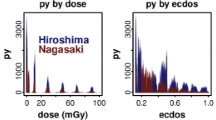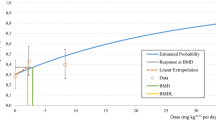Abstract
The risk of low-dose radiation exposures has – for a variety of reasons – been highly politicised. This has led to a frequently exaggerated perception of the potential health effects, and to lasting public controversies. A balanced view requires a critical reassessment of the epidemiological basis of current assumptions. There is reliable quantitative information available on the increase of cancer rates due to moderate and high doses. This provides a firm basis for the derivation of probabilities of causation, e.g. after high radiation exposures. For small doses or dose rates, the situation is entirely different: potential increases of cancer rates remain hidden below the statistical fluctuations of normal rates, and the molecular mechanisms of cancerogenesis are not sufficiently well known to allow numerical predictions. Risk coefficients for radiation protection must, therefore, be based on the uncertain extrapolation of observations obtained at moderate or high doses. While extrapolation is arbitrary, it is, nevertheless, used and mostly with the conservative assumption of a linear dose dependence with no threshold (LNT model). All risk estimates are based on this hypothesis. They are, thus, virtual guidelines, rather than firm numbers. The observations on the A-bomb survivors are still the major source of information on the health effects of comparatively small radiation doses. A fairly direct inspection of the data shows that the solid cancer mortality data of the A-bomb survivors are equally consistent with linearity in dose and with reduced effectiveness at low doses. In the leukemia data a reduction is strongly indicated. With one notable exception – leukemia after prenatal exposure – these observations are in line with a multitude of observations in groups of persons exposed for medical reasons. The low-dose effects of densely ionizing radiations – such as alpha-particles from radon decay products or high-energy neutrons – are a separate important issue. For neutrons, there is little epidemiological information. This has facilitated exaggerated claims of high neutron effects with reference to alleged dangers from transports of reactor fuel. However, in spite of limited information, it can be shown that the data from Hiroshima exclude the stated claims. New dosimetric information on neutrons may turn out to be highly informative with regard to an upper limit for the potential effects of neutrons and equally with regard to a reassessment – and a possible reduction – of risk estimates for gamma-rays.
Similar content being viewed by others
Author information
Authors and Affiliations
Additional information
Received: 13 November 1999 / Accepted in revised form: 13 December 1999
Rights and permissions
About this article
Cite this article
Kellerer, A. Risk estimates for radiation-induced cancer – the epidemiological evidence. Radiat Environ Biophys 39, 17–24 (2000). https://doi.org/10.1007/PL00007679
Issue Date:
DOI: https://doi.org/10.1007/PL00007679




